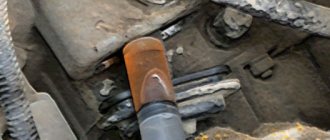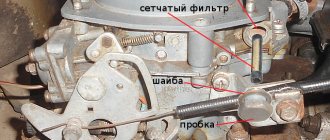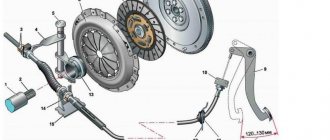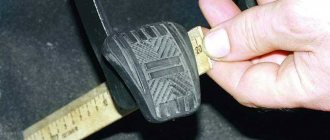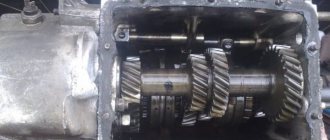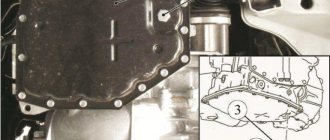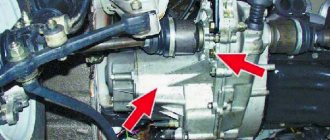The causes of noise in the gearbox depend on the type of transmission. So, in manual transmissions, a hum may appear, for example, due to wear of bearings, shaft gears, springs on the rocker, or differential. As for the automatic transmission, most often it hums due to low oil level, due to problems with the torque converter and the lever linkage.
To eliminate noise in the area of the box, it first makes sense to check the oil level in it. If it is not enough, then you need to top it up or replace it. As a temporary solution, an anti-noise additive is sometimes used in the box (it will not completely remove it, but at least reduce the operating noise). To effectively eliminate hum, the box should be dismantled, checked and fully repaired. Read about all the causes of noise in the gearbox in the article, and for brief information on why various types of noise appear in the gearbox, see the table.
| Conditions under which the gearbox makes noise | Possible causes of noise |
| Mechanical transmission | |
| Humming noise at speed (while driving) |
|
| At idle |
|
| When overclocking |
|
| When releasing the clutch |
|
| On a certain gear |
|
| In low gears (first, second) |
|
| In high gears (4 or 5) |
|
| In the cold |
|
| In neutral gear |
|
| Automatic transmission | |
| When driving at speed |
|
| In the cold |
|
| At idle |
|
| When overclocking |
|
| On a certain gear |
|
| At low speed (up to approximately 40...60 km/h) |
|
When you press the clutch, the noise in the box disappears.
A couple of days ago I completely replaced the clutch (406 doors).
During the first start of the engine I noticed a noise. I get behind the wheel, squeeze the clutch - the noise disappears, let go - it makes noise again! Has anyone encountered such a problem? And what could be the problem.
Have you changed the input shaft bearing?
Added after 2 minutes 29 seconds And most likely a squeeze. New doesn't mean good.
The same thing. I changed the oil seals on the box, well, I think, let me change the release button, it made a noise, when I pressed it was silent. I reached into the box (5 mortar), found that the outer race of the bearing of the 1st shaft was cracked, replaced it, the rest seemed to be ideal. The noise did not disappear. Today I took it to market 4x mortar for $35 (so that the car does not stand, it is very necessary almost every day), I pumped up manuals from the Internet, my 2CDs for GAZ, advice from mechanics from the taxi company - this weekend I will change it to a 4x mortar - and with God for the bulkhead (only myself, and I won’t trust any locksmith), slowly and carefully, at least for a month. Then I’ll write back.
That’s exactly what I did - I temporarily installed a 4-speed gearbox and took off my 5-speed gearbox for repairs.
Reason for repair _________________
The gearbox rustles at idle - and especially in 5th gear, the gears are switched on indistinctly - and only when you shift the throttle (synchronizers clearly do not perform their function)
Now I’ve disassembled it - detailed troubleshooting of the parts is underway. But we can already say with confidence that the bearings were rustling, as soon as you turn them by hand, they make a lot of noise - although everything is in grease. and there are no backlashes at all. The reason, it seems to me, may be in the fit on the shaft - perhaps too tight, we will measure it, and also, there were a few chips in the box - a wear product - from the coupling forks, the chips could be scattered with the oil - and fix it bearings in appearance - balls in bearings - with micro inclusions. In general, once I’ve done everything, I’ll post a detailed report on the work done with photos.
Added after 4 minutes 5 seconds and more
Car produced in 2001. I plan to put in the box updated double synchronizers (clutch assemblies), forks for them, as well as tapered bearings for the intermediate shaft..
Source
Automatic transmission - the hum is definitely not good
If you have an automatic transmission, CVT or robotic manual with automatic shifting, the hum definitely does not bode well for you. At any service, disassembling and reassembling your box alone will cost incredible amounts of money. Today you will not be too pleased with the prices for spare parts. Sometimes it is better to listen to the hum than to hear the price it takes to eliminate it. Use the help of specialists to diagnose the gearbox, but remember that a complete diagnosis of your machine is only possible if the box is disassembled. The most common causes of automatic transmission humming are as follows:
- in a conventional machine or in a robotic box, one of the elements of the main pair may wear out, causing a backlash in operation;
- the gears do not touch each other in normal modes, excessive friction of the mechanisms in the gearbox occurs;
- for a variator, a hum almost certainly means death or the need for major repairs - stretching of the main working mechanisms is not so rare;
- the box can also hum due to poor fastening of the axle shafts, which causes play at the joints and a rather strong hum;
- Bearings that have failed often hum; they will definitely show themselves in the near future;
- worn teeth on the drive gear or shaft will indicate the presence of backlash and constant hum in one or more gears.
Often, along with the hum, some other troubles with the gearbox begin to occur. For example, the transmission begins to throw out one of the gears after you release the gas pedal to slow down. The gear forks may be to blame for this, but it all depends on the gearbox, its type, design and other features. If for a manual transmission this problem is quite easy to overcome, then for an automatic transmission, dropping gears in unauthorized mode means the impossibility of operating the car. Otherwise, traveling in such a car will be unsafe. So always watch out for sounds coming from the machine and contact the service center to eliminate them.
The gearbox is noisy, when the clutch pedal is pressed there is silence,
> I have this noise from the bulkhead itself. I went through it myself, so I was sure that everything was assembled perfectly and gave up. === If it makes noise, it’s no longer ideal.
It's been making noise for over 10 times now. Apparently, the noise is made by the gears themselves. ==== Any mechanism makes noise. :-)) In this case, I think it’s worth checking the gearbox again.
Moreover, the TAD-17, for which these boxes were made, was much thicker than our current 80-90 transmission. ==== Hm. Another good way to reduce noise and thicken oil is sawdust. :-)) Effective, But not for long.
Yeah, shazz! > ==== Any mechanism makes noise. :-)) In this case, I think it’s worth checking the gearbox again.
Schazzz! I'll go over it again, and first, through numerous bulkheads, I'll eliminate the noise from the transfer case. Apparently you've already done this? Why go through it again? What to fix? Everything works perfectly, but when the clutch is pressed, you can only hear the engine, and when it is released, you can also hear the rustling of the box. Why go through what to change?
quoted1 > > It makes so much noise from the bulkhead itself. I went through it myself, so I was sure that everything was assembled perfectly and gave up. > === If it makes noise, it’s no longer ideal.
It's assembled perfectly, but I don't make shafts and bearings. The secondary shaft was chosen in Rus' from a complete marriage. In the end, I took the one on which the second (extra) groove for the key was made in the wrong place. I thought it was at least clear why he went to get married (and then to the store).
> Moreover, the TAD-17, for which these boxes were made, was much thicker than our current 80-90 transmission.
> ==== Hm. Another good way to reduce noise and thicken oil is sawdust. :-)) Effective, But not for long.
How to prevent gearbox failure
Early signs of future failure include:
- Difficulties appearing when changing gears. It becomes more and more difficult to change gears. Sometimes you have to squeeze the clutch and move the lever to neutral.
- The transmissions are flying out.
- Oil is leaking from the gearbox.
Data-lazy-type=”image” data-src=”https://vazremont.com/wp-content/uploads/2017/11/foto-5-5.jpg” alt=”Bearing wear” width=”604 ″ height=”454″ class=”lazy lazy-hidden size-full wp-image-4364″ srcset=”” data-srcset=”https://vazremont.com/wp-content/uploads/2017/11/foto -5-5..jpg 300w" sizes="(max-width: 604px) 100vw, 604px">
Another common cause of problems during gear shifting is due to improper adjustment of the shift actuator. Assembly parts often break and can also cause the problem. To eliminate problems, it is necessary to correct or replace the rod as soon as possible, as well as tighten the screws. Then you can start adjusting the drive and replacing the remaining non-functioning parts.
On some VAZ 2114 vehicles, a gear reset occurs. This process occurs spontaneously. The reason is wear or breakage of the teeth (end teeth) on the coupling. Sometimes the teeth on the gears fail. A similar problem arises due to insufficiently competent debugging of the drive. In other cases, the reason lies in inaccuracy during the installation of the traction cover, which is intended for protection.
To correct this problem, you may need to replace all faulty parts. Next you should start debugging the drive.
The next step is to install the cover in the required position. If an oil leak occurs, then it is necessary to install the crankcase and change any gaskets that look worn out. Do not forget about the need to remove the box before repairing.
Noise in the gearbox when the clutch is pressed, the noise disappears
#1 Ponkrat
Post edited by Ponkrat: September 05, 2012 - 15:48
#2 gerter
Please give me some advice, the box is noisy. Noise in all gears, a little less in fourth. The noise goes away when you press the clutch pedal. According to all the signs and the specialist's diagnosis - the input shaft bearing. What is it (the bearing) called correctly, where is it located in the box and the correct VIN code. They say you can find an inexpensive analogue. Thank you in advance.
#3 Ponkrat
#4 Fixx
That’s right, but the problem may not only be in one bearing, in addition, if you take it apart, then immediately change everything that is possible. Many people have this problem. For me (replaced the box), for Fixx (it still drives with a buzzing sound), topics were recently created with a similar question. Is there any point in renovation?! Someone wrote here that after reassembling the box it didn’t last long and it started humming again.
I've been driving a different box for a long time since May
Repair makes sense if you change absolutely all the bearings!
You can read what's what here, replacing the input shaft bearing didn't help
#5 gerter
I've been driving a different box for a long time since May
Repair makes sense if you change absolutely all the bearings!
You can read what's what here, replacing the input shaft bearing didn't help
#6 Fixx
Well, sorry, I didn't know. So I thought that replacing the input shaft was pointless.
Okay
for the author: you can generally drive a humming box for a very long time if the noise does not progress
#7 Dm. Sutyagin
for the author: you can generally drive a humming box for a very long time if the noise does not progress
#8 Fixx
I confirm. I've been traveling like this for two years now. Almost a year ago, in a hysterical fit, I bought a new one, but never installed it.
#9 Ponkrat
#10 Fixx
#11 gerter
Thank you! I’ll drive until I die, and in the meantime I’ll fill it with new oil) I’ll look for a box in the future.
#12 Dm.Sutyagin
Fill in the XADO additive, but I can’t tell you which one, you need to ask people. Many people have tried it and they say that the noise goes away.
#13 Fixx
Well, after the last discussion of this topic, I decided to fill myself with it. Like, I don’t feel that sorry for the box anymore, I have a spare one. I've already driven about 1.5 thousand. I don't hear any significant improvements. And they promised that the effect would appear after 500 km. Maybe he only appears if you firmly believe in him?
#14 Dm.Sutyagin
So a loading dose is poured in there, like 2-3 servings
#15 Fixx
If NOT the drums cost a thousand rubles, then what the heck, such experiments. It's a pity for the money.
#16 Justice
When there is no replacement, this is the last resort to escape the noise!
#17 Fixx
#18 gerter
I won’t confirm, maybe it doesn’t help, but without disassembling this is the only way to make the noise quieter
#19 Guest_Asturn_*
#20 ivanich_2.0
Please give me some advice, the box is noisy. Noise in all gears, a little less in fourth. The noise goes away when you press the clutch pedal. According to all the signs and the specialist's diagnosis - the input shaft bearing. What is it (the bearing) called correctly, where is it located in the box and the correct VIN code. They say you can find an inexpensive analogue. Thank you in advance.
Post edited by ivanich_2.0: September 17, 2012 - 22:58
How to choose a new release bearing
If the release bearing is clearly damaged, you should immediately buy a new one and replace it.
On the auto parts market there are release bearings of both domestic and foreign production, their cost ranges from 300 to 1600 rubles.
These are models from the following manufacturers:
- AvtoVAZ (TZA) - Russian Federation (this VP is original and is produced in two versions - standard type and with a reinforced coupling);
- TORQUE – Finland;
- VBF – Russian Federation;
- SKF - Sweden (is an analogue of the premium class);
- LUK - Germany (like the previous one, it is an analogue of the premium class).
The new release bearing must last at least a million on-off cycles. The strength and quality of materials of most release bearings correspond to this figure. But without following some recommendations, even the best release bearing will quickly fail.
There are five easy-to-follow recommendations in total:
- After replacing the VP, all bolted connections of the assembly parts must be coated with a sufficient layer of graphite lubricant;
- When installing it, the release bearing itself must be lubricated with the recommended lubricant in the required quantity;
- During operation, you need to ensure that water and dirt do not enter the transmission - if this happens, then breakdown is inevitable;
- Do not hold the clutch pedal down for a long time;
- Follow the order of pressing the pedal - fast pressing and slow release, without delays in the intervals between the extreme points.
Noise in the gearbox when the clutch is pressed, the noise disappears
#1 Ponkrat
Post edited by Ponkrat: September 05, 2012 - 15:48
#2 gerter
Please give me some advice, the box is noisy. Noise in all gears, a little less in fourth. The noise goes away when you press the clutch pedal. According to all the signs and the specialist's diagnosis - the input shaft bearing. What is it (the bearing) called correctly, where is it located in the box and the correct VIN code. They say you can find an inexpensive analogue. Thank you in advance.
#3 Ponkrat
#4 Fixx
That’s right, but the problem may not only be in one bearing, in addition, if you take it apart, then immediately change everything that is possible. Many people have this problem. For me (replaced the box), for Fixx (it still drives with a buzzing sound), topics were recently created with a similar question. Is there any point in renovation?! Someone wrote here that after reassembling the box it didn’t last long and it started humming again.
I've been driving a different box for a long time since May
Repair makes sense if you change absolutely all the bearings!
You can read what's what here, replacing the input shaft bearing didn't help
#5 gerter
I've been driving a different box for a long time since May
Repair makes sense if you change absolutely all the bearings!
You can read what's what here, replacing the input shaft bearing didn't help
#6 Fixx
Well, sorry, I didn't know. So I thought that replacing the input shaft was pointless.
Okay
for the author: you can generally drive a humming box for a very long time if the noise does not progress
#7 Dm. Sutyagin
for the author: you can generally drive a humming box for a very long time if the noise does not progress
#8 Fixx
I confirm. I've been traveling like this for two years now. Almost a year ago, in a hysterical fit, I bought a new one, but never installed it.
#9 Ponkrat
#10 Fixx
#11 gerter
Thank you! I’ll drive until I die, and in the meantime I’ll fill it with new oil) I’ll look for a box in the future.
#12 Dm.Sutyagin
Fill in the XADO additive, but I can’t tell you which one, you need to ask people. Many people have tried it and they say that the noise goes away.
#13 Fixx
Well, after the last discussion of this topic, I decided to fill myself with it. Like, I don’t feel that sorry for the box anymore, I have a spare one. I've already driven about 1.5 thousand. I don't hear any significant improvements. And they promised that the effect would appear after 500 km. Maybe he only appears if you firmly believe in him?
#14 Dm.Sutyagin
So a loading dose is poured in there, like 2-3 servings
#15 Fixx
If NOT the drums cost a thousand rubles, then what the heck, such experiments. It's a pity for the money.
#16 Justice
When there is no replacement, this is the last resort to escape the noise!
#17 Fixx
#18 gerter
I won’t confirm, maybe it doesn’t help, but without disassembling this is the only way to make the noise quieter
#19 Guest_Asturn_*
#20 ivanich_2.0
Please give me some advice, the box is noisy. Noise in all gears, a little less in fourth. The noise goes away when you press the clutch pedal. According to all the signs and the specialist's diagnosis - the input shaft bearing. What is it (the bearing) called correctly, where is it located in the box and the correct VIN code. They say you can find an inexpensive analogue. Thank you in advance.
Post edited by ivanich_2.0: September 17, 2012 - 22:58
Source
Problems with the VAZ-2109 gearbox
There can be many reasons for a gearbox malfunction in a VAZ-2109. First, determine what signs characterize the breakdown. If difficulties arise when switching speeds, the malfunctions may be as follows:
- Not enough or too little lubricant mixture.
- The gearshift shaft is jammed.
- The integrity of the gearbox gears is damaged.
- A foreign object accidentally entered the gearbox.
- A part called the synchronizer slide has worn out and can no longer be repaired.
If, while the vehicle is moving, a gear slips out or the gear lever returns to the neutral position, the reasons are indicated in the following list:
- The defect indicates a defect during the production of the VAZ-2109 unit. That's why, when buying a car, you need to carefully monitor the correct operation of all devices; do not hesitate to ask the seller tricky questions, after all, you pay. Warranty car repairs also do not mean that the part will eventually be repaired.
- The teeth of the gears are worn out, then the crown with teeth becomes like a cone and the destruction of the fixation of the gears becomes obvious.
- If the condition of the VAZ-2109 gearbox shaft, gears or bearings leaves much to be desired, then the bearing moves out of place or moves slightly to the side.
Car enthusiasts on forums dedicated to the maintenance and repair of the VAZ-2109 indicate additional defects and malfunctions of the car’s gearbox:
- Noises appear, indicating wear of the bearings and gears; the result of such a malfunction may be the lack of adequate adhesion of the components. The damage most likely affected the synchronizer or the box structure. The noise may be accompanied by knocking. Driving such a car is dangerous to the health and life of the driver and passengers.
- If you notice oily spots under the vehicle, you should assume that the transmission is leaking. Why does this problem occur? If the crankcase cover does not fit tightly or it is time to replace the oil seal shaft. You can fix problems yourself without resorting to the expensive services of service station specialists.
- Overheating of the gearbox is another unpleasant factor, which means that too little oil is filled.
When you press the clutch, the noise in the box disappears.
- To the beginning of the forum
- Forum Rules
- Old design
- FAQ
- Search
- Users
Car 2115. It runs at idle speed, tyr-tyr-tyr. It's not loud, but you can make it out. I press the clutch, perfect condition. What would it be?
In theory, the input shaft of the box. Right now there are two topics on our page - take a look. Otherwise, the presser may still rustle - just change it. PS, in any case, you can score because immaterial.
So if I don’t want it to be there, what should I change? As I understand it, the presser should rustle when I press it?
Operating principle
The purpose of the device is to ensure uninterrupted connection and disconnection of the clutch discs when the driver presses the pedal.
The operating principle is as follows:
- Through the action of the pressure plate, the driven shaft is pressed against the clutch flywheel.
- The system generates pressure, which is applied to the pressure shaft; this is ensured through the use of a diaphragm spring. Its inner petals are affected by a bearing device.
- The part moves, resulting in separation of the shafts through the action of the fork.
User Alexey Romanov published a video that will help you understand the principle of operation of the clutch system and release bearing.
Knock when switching automatic transmission: main faults
VAZ 2110 gear shifts poorly: causes, troubleshooting, transmission diseases
So, one of the common reasons why owners of cars with automatic transmissions turn to car repair shops for diagnostics is the appearance of noises and knocks in the automatic transmission. Typically, a knocking sound when shifting gears is accompanied by incorrect operation of the unit, but this does not always happen.
In any case, if the driver clearly hears that the automatic transmission is knocking in the box, then this is a reason to stop using the vehicle and carry out in-depth diagnostics.
If there is a knocking noise in the automatic transmission, the causes of the malfunction may be different. The fact is that an automatic transmission (especially when it comes to hydromechanical automatic transmissions) is a complex unit that includes a large number of mechanical, hydraulic and electronic components.
To identify the source of automatic transmission knocking, just look at the list of common faults:
- low or high level of transmission oil in the automatic transmission;
- incorrect clearances between brakes and clutch packs;
- stuck valves in the automatic transmission valve body or mechatronics;
- problems with solenoids, pressure regulator;
- malfunctions in the operation of actuators, automatic transmission ECU;
- wear or damage to individual elements in the box;
- wear of engine and automatic transmission mounts, etc.
It would seem that there are a lot of reasons and knocking in the automatic transmission, as well as impacts in the automatic transmission, are extremely difficult to localize (especially in the case of a hydromechanical automatic transmission when changing gears). However, in practice, in some cases it is possible to determine a breakdown by the nature of the knock.
First of all, when changing gears in an automatic transmission, the angular acceleration of the output shaft through which torque is transmitted is constant. In this case, the angular speed of the pump wheel and turbine wheel in the torque converter changes. Also, the crankshaft of the internal combustion engine rotates at different frequencies.
Due to the presence of a large number of ECM sensors, various processes are “monitored” by electronics, and errors are recorded in case of certain failures. As for the automatic transmission, if there is an automatic transmission error, this makes the task easier. However, often knocks and knocks are not displayed as a fault code, which can be easily read during diagnosis from the automatic transmission ECU using diagnostic equipment.
In simple words, the automatic transmission may knock during operation, but there are no diagnostic errors. This means that there is a problem, but the system cannot recognize and record problems in the automatic transmission
In such a situation, it is important to understand that manufacturers of many gearboxes have, until today, not been able to implement effective control over all processes in the transmission (due to the complexity of the unit devices).
For example, a malfunction of the automatic transmission differential leads to a grinding or knocking sound in the automatic transmission in the place where the differential is installed. The reason is wear of the differential drive or driven gear, wear of the differential bearing, and an increase in the axial clearance. It is also possible that the pin of the pinion gears in the differential may become stuck, causing noticeable play.
In some cases, knocking in the automatic transmission appears as a result of problems not with the box itself, but with the gas turbine engine. In this case, the torque converter often knocks due to its own malfunctions or imbalance.
If the driver notices knocking noises in the automatic transmission when shifting, this knock may well be the reason that there are problems in the gas turbine engine. It must be remembered that the higher the angular speed of the turbine wheel of a gas turbine engine, the more energy is released.
In a situation where the change in angular velocity differs from the calculated one, this leads to switching, which is simultaneously accompanied by knocking. Another knocking sound in the automatic transmission when reverse gear is engaged and increased vibration are the result of the inertia of the turbine wheel due to a sharp change in angular velocity.
A slight jolt and a slight knock in this case is quite acceptable, but there should be no impact. Also, when detecting knocking noises while engaging reverse gear, it is recommended to linger for 1-2 seconds in “N”, and then move the selector to “R”. Such a change in the habit of switching to reverse gear not abruptly in the case of an automatic transmission will make the switching itself soft and smooth.
If we take into account all of the above, it becomes clear that knocking noise due to problems with the torque converter occurs as a result of failures when changing the angular speed of the gas turbine turbine. As a rule, a change in this speed occurs precisely at the moment of gear shifting. Ultimately, this becomes the cause of the knocks that the driver hears.

